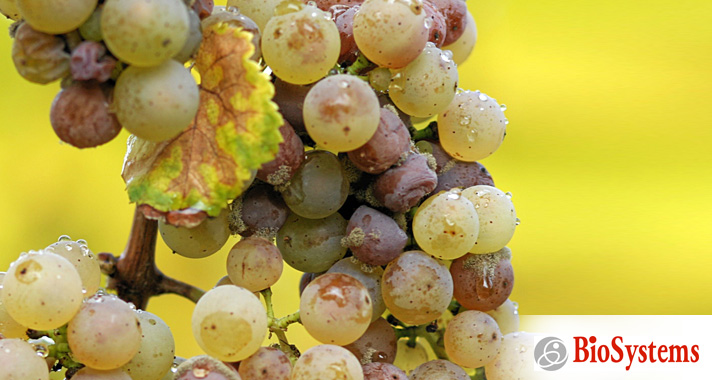Gluconic acid is used globally as a rapid screening tool for assessing fruit quality on incoming fruit, even so far as influencing the price and/or rejection criteria in vineyard contracts.
Monitoring for gluconic acid for botrytis affected grapes
Gluconic acid
Gluconic acid – D-Gluconic acid (gluconate) is a metabolite of Botrytis and can be a useful marker for Botrytis activity in the vineyard. It is associated with a sour taste and has an overall negative effect on quality. Gluconic acid is used globally as a rapid screening tool for assessing fruit quality on incoming fruit, even so far as influencing the price and/or rejection criteria in vineyard contracts.
Enzymatic test kit
Biosystems manufacture an enzymatic test kit for the monitoring of gluconic acid that can be used on any of their fully automated instrument or any spectrophotometer that can measure absorbance at 340nm. This give the winemaker an easy to use method to monitor for this issue with incoming grapes to their winery.
Botrytis cinerea or grey rot occurs worldwide
Gluconic acid is one of the most important metabolites associated with grape Infection by Botrytis cinerea or grey rot. This pathogen occurs worldwide, particularly in vineyards exposed to wet conditions during ripening. The ability to do a fast and accurate determination of the infection allows for an effective screening of grape lots, and gives the winemaker the opportunity to adapt their winemaking strategy.
Penalty levels
Countries like France (in particular Champagne), Spain, Portugal, Argentina and Chile have already adopted this as the key parameter to determine how much to penalize the payment on Botrytis infected grapes, as well as a winemaking decision tool. Some wineries reject grapes if the content of gluconic acid is over 0.5 g/L. Levels of 0.2 – 0.3 g/L are a red flag and require action.
Infection of Botrytis cinerea
An infection of Botrytis cinerea negatively affects grape quality and the
resulting wine. Grapes affected by grey rot have a high sensitivity to oxidation (laccase) and show a reduction in sugar, acids and polyphenol composition with problematic alcoholic fermentations and high spoilage microbe contaminations. In addition to off-flavour development and high SO2 binding, resulting wines have colour, clarification and stability problems.
Loss of aroma
Wines obtained from Botrytis-infected grapes lose varietal aroma while “dusty,” “earthy,” “dirty” and off flavours appear. For this reason, the presence of gluconic acid is an important marker used by winemakers to estimate the level of Botrytis cinerea infection of grapes and adapt their winemaking process.
Recommended levels
The Organization Internationale du Vin (OIV) recommends levels of gluconic acid lower than 0.2 – 0.3 g/L, whereas levels up to 1.0 g/L indicate an initial stage of fungus infection.
The solution
Biosystems manufacture an enzymatic test kit for the monitoring of gluconic acid that can be used on any of their fully automated instrument or any spectrophotometer that can measure absorbance at 340nm. This give the winemaker an easy to use method to monitor for this issue with incoming grapes to their winery.









